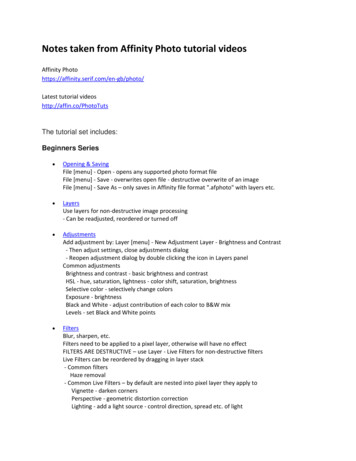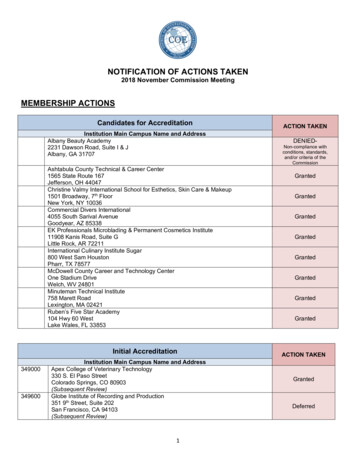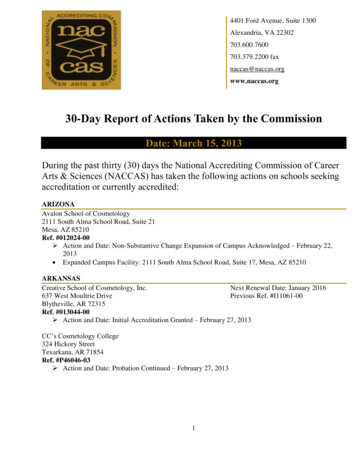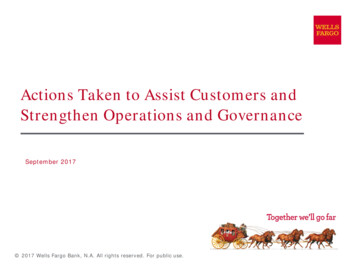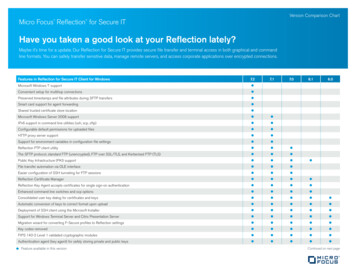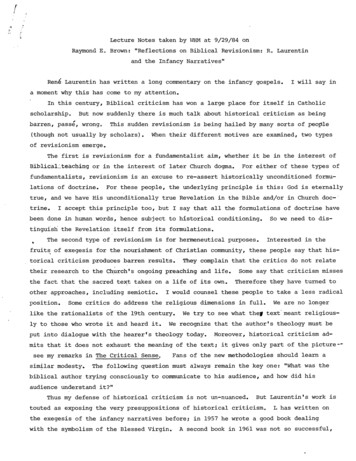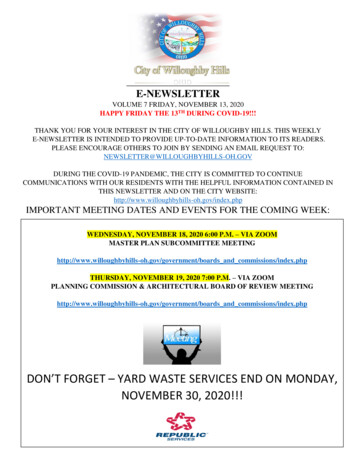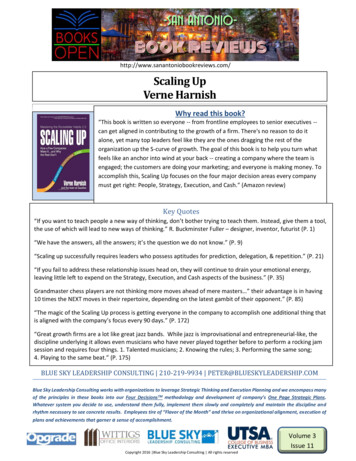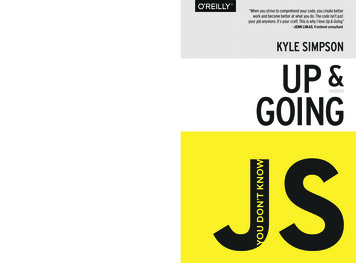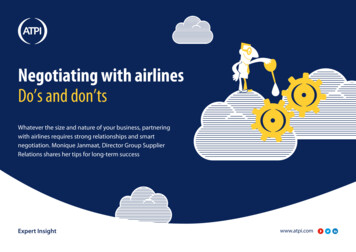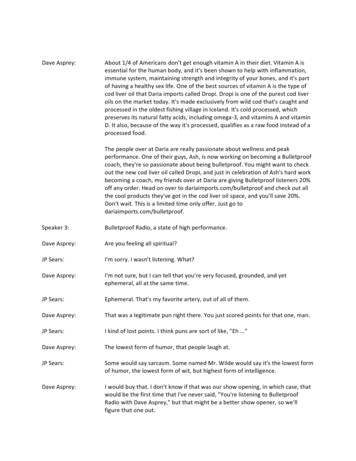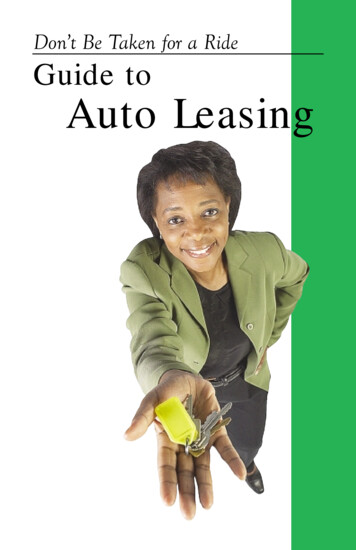
Transcription
Don’t Be Taken for a RideGuide toAuto Leasing
Table of ContentsIntroduction . . . . . . . . . . . . . . . . . . . . . . . . . . . . . . . . 1If you are considering leasing a vehicle, you should know that . . . . 2Why do people lease? . . . . . . . . . . . . . . . . . . . . . . . . . 2What is a lease? . . . . . . . . . . . . . . . . . . . . . . . . . . . . . 2How often do you purchase a new vehicle? . . . . . . . . . . 3What can you afford? . . . . . . . . . . . . . . . . . . . . . . . . . 4Do you put a lot of wear and tear on a car? . . . . . . . . . 4Understand the effect of trade-ins and down payments . . . . 5Be on the lookout for special factory-subsidized lease deals . . . 5Balloon-Note Financing . . . . . . . . . . . . . . . . . . . . . . . 5-8O.K., so you think leasing is a good idea for you . . . . . 8Know the language of the industry . . . . . . . . . . . . . . . . 8Auto Leasing Guide Glossary. . . . . . . . . . . . 9-18Let’s review the basics of buying a car . . . . . . . . . . . . . 18Now, let’s look at leasing . . . . . . . . . . . . . . . . . . . . . . 19Learn how to calculate the interest rate or “money factor” . . . . 20What are your insurance needs? . . . . . . . . . . . . . . . . . 21The Buy-Out . . . . . . . . . . . . . . . . . . . . . . . . . . . . . . . 21Advertising requirements for lessors . . . . . . . . . . . . . . 21What to expect at the end of the lease . . . . . . . . . . . . 23Conclusion . . . . . . . . . . . . . . . . . . . . . . . . . . . . . . . . 24
IntroductionIn recent years, the number of drivers who lease rather than buytheir cars has increased tremendously. A large percentage of NewJersey residents now lease a vehicle. Unfortunately, as the number ofleases has increased, so has the number of complaints ofconsumer fraud and deception.New Jersey’s Consumer Protection Leasing Act (“C.P.L.A.”),N.J.S.A. 56:12-60 et seq., established what are perhaps the strongestmotor vehicle leasing standards in the nation. The law ensuresgreater protection for New Jersey consumers by requiring lessors todisclose detailed information about crucial terms of their leases.On October 1, 2005, the New Jersey Streamlined Sales and Use TaxAgreement became effective. This legislation made significant changesto the New Jersey Sales and Tax Use Law and changed the formula forcalculating the tax on auto leases.In addition, the Board of Governors of the Federal ReserveSystem has changed the federal leasing law. The federal leasing law,which took effect on January 1, 1998, incorporates many of theconcepts embodied in New Jersey’s C.P.L.A.The C.P.L.A. requires the Division of Consumer Affairs(“Consumer Affairs”) to educate consumers about leases. As part ofits statutory obligations, Consumer Affairs has prepared thisbooklet. With the help of this booklet, the “Don’t Be Taken For aRide Guide to Auto Leasing,” you can determine whether leasing orbuying is right for you and, if you do lease, how to ensure that youwill negotiate the best possible deal.1
If you are considering leasing a vehicle, you should know that.The most important right you have as a lessee is to be free fromfraudulent practices. However, you should also realize that you havea right to receive important information that is accurate, includingthe material terms and conditions that will be a part of your lease,without having to endure undue sales pressure and confusing ormysterious language. The C.P.L.A. and the Consumer Fraud Act(“C.F.A.”), N.J.S.A. 56:8-1 et seq., incorporate these rights for NewJersey consumers into law.Why do people lease?The lure of a lease is its monthly price. Consumers often findthat they can lease cars at lower monthly payments than they wouldif they were purchasing. Advertisements of “no down payments,”“low monthly payments” and “more car for your dollar,” arenaturally very appealing.The United States Department of Commerce reports the averageprice of a new car is approximately 23,049. As a result, moreconsumers are leasing as an alternative to buying new vehicles.Before you make up your mind and lease that fancy sports car orsport utility vehicle, ask yourself two basic questions:1) “Will it be cheaper in the long run to buy or lease thisvehicle?” and2) “If I lease, how do I get the best deal?”What is a lease?A lease is basically a long-term rental agreement – more than 120days – to drive a vehicle owned by someone else. You are paying forthe right to drive that vehicle and are paying for the value of the carwhile you drive it. When the lease is over, you must give the vehicleback unless you have the option to buy it.2
Before you sign the lease contract, take the time to review itcarefully. Write down any questions that may arise during yourreview, and be sure to pose any questions you may have to thesalesperson. Make sure you understand the answers to yourquestions before signing the contract. Also, be certain to geteverything in writing. For example, if you’re told that you can turnthe car in early without having to pay an extra penalty, don’t take thesalesman’s word for it, get it in writing and as a lease addendumsigned by the dealer/lease company, not just on a blank piece ofpaper signed by the salesman. Usually, if it is not on the printedcontract, it is not binding.Under the C.P.L.A., you are given a one-day cooling-off period toreview the lease contract. This innovative provision allows you tobring the unsigned agreement home to review the numbers and todetermine whether that agreement is right for you. Not doing socould prove costly.A lessor may suggest that you waive your right to review thecontract; however, you might not want to do that. In fact, you shouldthink long and hard before doing so. Remember, there are very fewdeals that are so good that they will not be available 24 hours later.The waiver has specific wording which is: I HAVE BEEN ADVISEDTHAT UNDER THE NEW JERSEY CONSUMER PROTECTIONLEASING ACT, N.J.S.A. 56:12-60 et seq., I AM ENTITLED TOREVIEW THE LEASE CONTRACT FOR ONE 24-HOURBUSINESS DAY BEFORE SIGNING. I CHOOSE TO WAIVETHAT RIGHT AND SIGN THE LEASE NOW. In addition, thereis a form provided by the Division of Consumer Affairs that providesthe essential elements of the lease disclosure.How often do you purchase a new vehicle?When you consider buying versus leasing, you need to askyourself how long you plan to keep the vehicle. The averageconsumer buys a new vehicle every four years. If you are one of theseconsumers or if you trade in your car every two or three years, a goodleasing deal may be better for you. If you tend to keep your car for alonger period of time, purchasing a vehicle may be better. The longer3
you drive a car on which payments are no longer due, the lower theaverage of your monthly costs are likely to be.Example: A car priced for sale at 20,000 and with 20,000financed will cost 555.56 a month for 36 months, 416.67 a monthfor 48 months or 333.33 a month over 60 months, plus interestcosts. When leasing that same car, monthly payments are fixed at alower amount because you are not paying off the entire purchaseprice and there is a residual value you have not paid – regardless ofthe length of the lease.Another consideration is crucial. At some point, the owner of acar no longer makes payments and drives it for “free.” When he orshe goes to buy or lease another vehicle, he or she has the car whichhas been paid for in full as an asset to trade in towards his or her nextpurchase or lease. In contrast, when a consumer returns his or herleased vehicle, he or she has nothing to trade in towards the cost ofa new lease or purchase.What can you afford?Many consumers are attracted to lease deals because ofadvertised low monthly prices. While everyone likes low prices, theremay be additional, less-obvious costs associated with leasing. In thelong run, these expenses may cost you more than buying the car.Lessors charge any number of fees at the beginning and end of thelease which may not appear when you purchase a vehicle. These feesadd up and may make that “good” deal less appealing.Do you put a lot of wear and tear on a car?If you are rough on your automobile, then leasing is probablyNOT for you. Lessors typically charge for “excess wear and tear.” TheC.P.L.A. helps you sort out what this phrase means, but if your carstend to become scratched or dented, you can expect additionalcharges at the end of your lease. These repairs that need to be madebecome an out-of-pocket expense for you.4
Understand the effect of trade-ins and down payments.The key thing to remember is that any money you put down onyour lease or any vehicle that you have used as a trade-in to reduceyour monthly payments is money that you no longer have availableto you, and money you will not get back at the end of the lease.While you are able to lower your monthly payment, you will not havethat money to purchase another car at the end of the lease. You alsowill not have one car to trade in for another. At the end of the lease,whether you have put no money down or have put several thousanddollars down, the leasing company will charge you the same amountof money for the car should you choose to purchase it. The onlything you accomplish with a down payment or a trade-in is to loweryour monthly payments and reduce the amount you have to pay intaxes.Be on the lookout for special factory-subsidized lease deals.To make a lease more attractive to consumers, car manufacturersmay adjust the residual value (see page 15) or lower the financecharges on the vehicle being leased. Doing this allows them to offerleases through their companies at lower money factors (see page 13)than those offered by banks. They realize that consumers who leasevehicles from them do more repeat business than consumers whopurchase vehicles. The dealer’s profit is on the difference betweenthe price the dealer paid for the vehicle and the price the dealer sellsthe vehicle to the leasing company for, as well as items such asservice contracts, alarms and undercoating the car.Balloon-Note Financing.A form of auto financing that is similar to a lease that has gainedin popularity is called “balloon-note” financing. It is structured likea lease in that the consumer makes payments on the vehicle for theterm of the contract (usually a term of 24, 36 or 48 months). At theend of the contract a balance or a “balloon-note” amount remains.5
The balloon amount is the value the financial institutiondetermines the vehicle will be worth at that time. This is usuallyseveral thousand dollars. That value is the expected market value,which is normally determined using a residual guide in the samemanner the residual value of a lease is computed. Thus theconsumer only pays the amount the vehicle depreciates during theterm of the contract. One difference between balloon-note financingand leasing is that the vehicle is owned by the consumer instead of aleasing company. It is considered a financed transaction so leasingregulations do not apply; however, financing regulations do apply.Another consideration is that, on a balloon-note transaction, theconsumer pays sales tax on the entire purchase price of the vehicle.On a lease, the tax is only on the amount of the payments and othertaxable items that you may pay for separately. However, there is notax paid in the beginning on the residual value. Thus, if theconsumer wishes to keep the vehicle at the end of the paymentportion of the contract there is no additional sales tax due on aballoon-note vehicle, but on a lease there is tax on the residual purchase price.Since the payment amount on a 48-month (or any term)balloon-note financed vehicle is significantly less than on aninstallment sales contract where the entire vehicle is paid off at theend of the contract, many consumers find it advantageous to financethis way. When trying to determine what is best for them, consumersshould look into all aspects of the arrangements and choose whatthey feel is best for them. Consumers should also carefully considerevery detail of a leasing agreement, such as the number of miles thatwill be driven as well as being responsible for any excess wear and tearwhen the vehicle is turned in.In addition, federal law (signed in the summer of 2005) removesthe vicarious liability from the leasing companies, which may causereduced incentives on balloon-note financing. Consequently, theremay be more incentives and lower rates directed toward leases,making balloon-note financing less attractive to consumers.At the end of your balloon-note contract, you would in mostcases have several options. You can pay the final balloon paymentand keep the vehicle, refinance the balloon note into equalpayments and keep the vehicle, or turn it in to the financial6
institution and pay the predetermined fee. Keep in mind thecontract usually calls for a mileage limitation and conditionqualifications, just as there are on a lease.One of your primary considerations should be, once you havedecided on the vehicle you want, to find out the particulars of thedifferent financing and leasing plans available and then pick the onethat best suits your needs. If you are not sure if you want a lease or apurchase with a balloon note, you can ask the dealer to compute thepayments on each plan on the same vehicle with the same amountpaid down. All things being equal, the balloon note should haveslightly higher payments due to the higher amount of tax being paidup front. However, this is not always the case because the incentivesin the balloon note deal may be different from the incentives in theleasing plan. It is important that all aspects of the program areexplained to you by the dealer.It is also important that the dealer explains to you, and youunderstand, that it is a balloon note and that the vehicle will not bepaid off at the end of the contract. You need to fully understand allof your choices. It is also critical that you read and understand thecontract and any associated paperwork prior to signing thepaperwork.Balloon-note financing is done predominantly by captive(manufacturer’s) finance companies such as GMAC, Ford MotorCredit, Chrysler Credit, etc. Many larger banks such as Chase mayalso offer the plan. GMAC calls it “Smart Buy” and has a separaterider that must be signed in addition to the base contract. Ford’scontract is called a “Simple Interest Balloon Contract,” andDaimlerChrysler’s contract is called “Fixed Value.” Be cautiousbecause in some contracts the only way you may be able to tell thatit is a balloon note is by reading it carefully, especially in the sectionthat spells out the number of payments and the amount of eachpayment. At that spot the contract should show an additionalpayment with the large balloon amount.This is just one more way to obtain a vehicle, but remember thatit is up to you to decide what is best for you. If you do not feelcomfortable about how the dealer is explaining things or answeringyour questions, you do not have to lease or purchase the vehicle. It7
is O.K. to tell the dealer you need more time to do research or tothink about whether or not balloon-note financing is the option foryou. In addition, any different terms or arrangements should benoted in the contract and if they are not there, they must be on aseparate form on the dealership’s letterhead and this form must besigned by the dealership’s management, not just by your salesrepresentative. Obtaining a vehicle should be a comfortable andpleasant experience and in most cases if a deal feels too good to betrue, it usually is.O.K., so you think leasing is a good idea for you.You have asked yourself all the right questions and the answersadd up to the same conclusion: you want to lease. Now is the timeto ask yourself two crucial questions. First, “How does the lessorcalculate the monthly payment?” Second, “Can I get a lowermonthly rate?” You can’t answer the second question unless youknow the answer to the first. Once you understand how the lessorsets the monthly rate, you can negotiate with the lessor oneven footing.Know the language of the industry.The first step is to understand the key terms of the lease. Manyof the terms in a lease have special meaning – particularly the keywords. Before you negotiate your lease, you should learn thesespecial definitions. You may know terms such as “down payment”and “MSRP,” but you may not be familiar with others such as “capcost” and “gap coverage.” Once you have learned the terms used bylessors, you will be better prepared to negotiate your lease. Thefollowing glossary will help you to become more familiar with theterms used in leasing and, as a result, help you to be better preparedto negotiate your lease.8
Auto Leasing GuideGlossary
Adjusted Capitalized Cost –This is the amount used in calculating your base monthlypayment. It is the Gross Capitalized Cost minus any CapitalizedCost Reduction.“After-Sell” Items –This is any product or service sold to the consumer by thedealership which is not otherwise standard equipment. Theseadditions could be items such as a CD player, alarm system, lifeand disability insurance, extended service contracts, undercoating, etc.Administrative Fee –This term is also referred to as a bank fee or an acquisition fee.This is a fee charged by a leasing company to process aconsumer’s lease application. It is usually incorporated in theGross Capitalized Cost. However, this amount may be paid upfront as a separate charge.Capitalized Cost, Cap Cost or Gross Capitalized Cost –This is equivalent to the selling price. This is the starting pointfor calculating your lease costs and includes a dollar value for thecar plus any additional charges such as: service contracts; additional equipment including a CD player, alarm system,undercoating, etc.; and any outstanding prior balance on a trade-in.You do have the option to be provided with a separate list of theitems included in this cost if they are not already listed in thecontract. Also included is the seven percent New Jersey Use Taxwhich as of October 1, 2005, is calculated in a different way thanit was in the past.Capitalized Cost Reduction –This is similar to a down payment. This can include amounts tobe paid in cash, noncash credit, rebate and/or trade-in9
allowance. Since this reduces the monthly lease payments, it istaxable, except for the trade-in, which is not taxable. This is oneway to reduce your monthly payment but it is not money thatyou will recover at the end of the lease. You are basically payingpart of the monthly payments in one lump sum, therebyreducing the amount due each month.Car Lease –This is a form of renting a car for a longer term (over 120 days), asdefined by New Jersey law. The vehicle is usually leased at adealership. The vehicle and the lease are then purchased by aleasing company. The lease is memorialized in a written contract.There are two types of leases: closed-end leases and open-end leases.Closed-End or “Walk-Away” Lease –A lease where the lessee returns the car without owing anymoney at the end of the lease term except for excess mileage andwear and tear. “Open-End Lease” is the other type of lease and isdefined here in the glossary. (See page 14 for the definition of“open-end lease.”)Depreciation –The value that the vehicle loses during the lease term. It is thedifference between the vehicle’s capitalized cost and the vehicle’svalue when the lease expires (residual value).Disposition Fee –This is very important for consumers to understand beforesigning the lease. A “disposition fee” is defined also as areconditioning fee, an end-of-term fee or a termination fee. It isa charge, usually no more than 500, that must be paid upontermination of the contract. If the consumer has made asecurity deposit, the disposition fee could be taken from that andthe consumer will be billed for the remaining balance, if anyremains.10
Down Payment –See “Capitalized Cost Reduction.”Early Termination –There
A form of auto financing that is similar to a lease that has gained in popularity is called “balloon-note” financing. It is structured like a lease in that the consumer makes payments on the vehicle for the term of the contract

